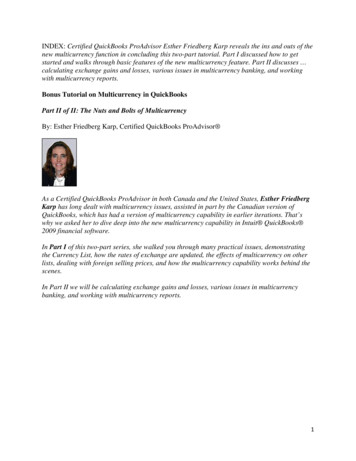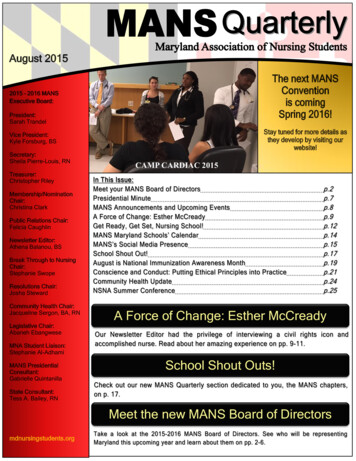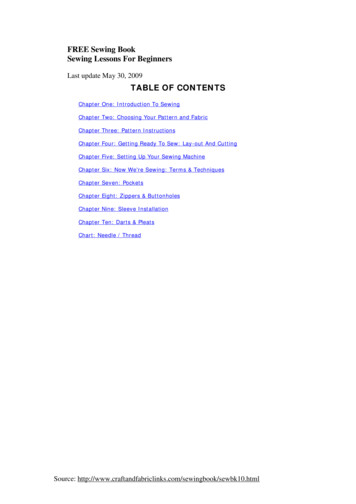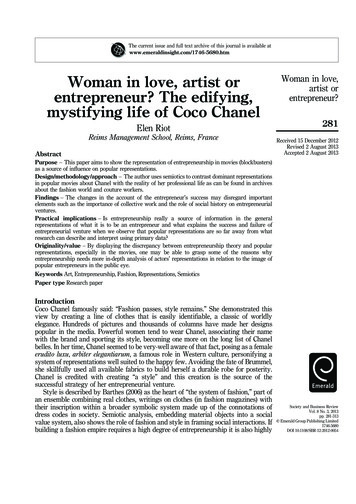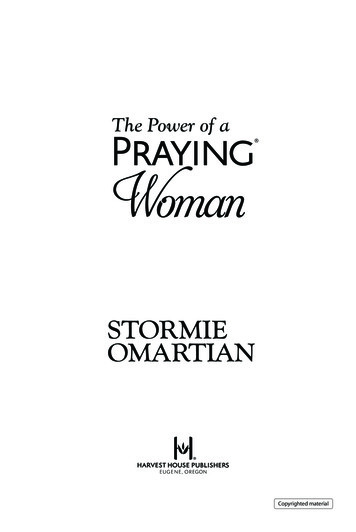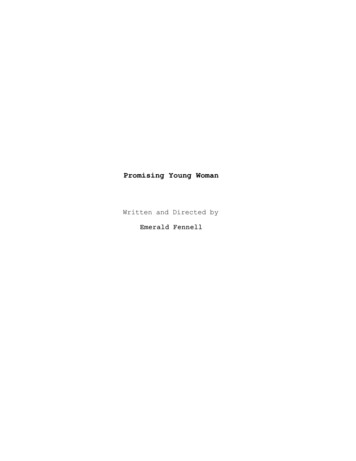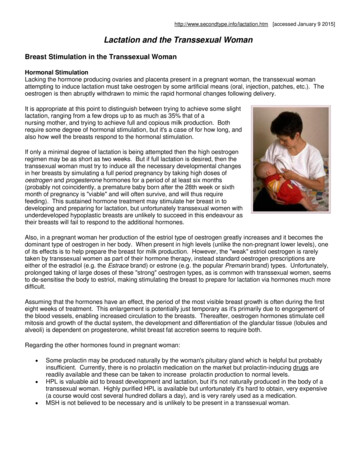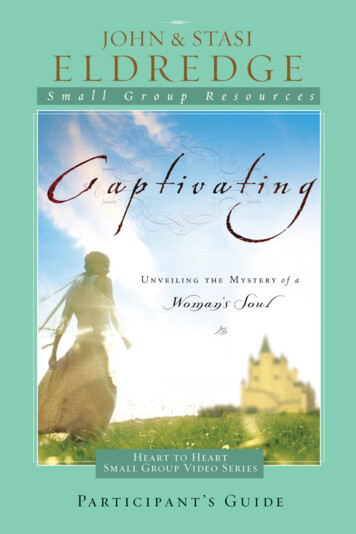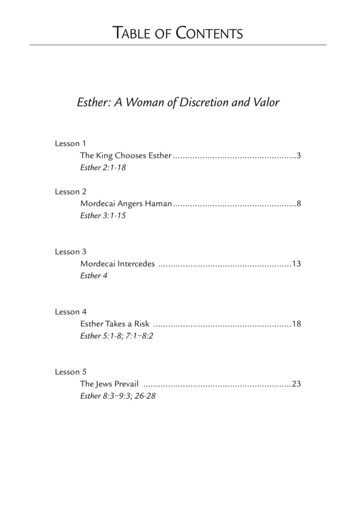
Transcription
TABLE OF CONTENTSEsther: A Woman of Discretion and ValorLesson 1The King Chooses Esther .3Esther 2:1-18Lesson 2Mordecai Angers Haman.8Esther 3:1-15Lesson 3Mordecai Intercedes .13Esther 4Lesson 4Esther Takes a Risk .18Esther 5:1-8; 7:1–8:2Lesson 5The Jews Prevail .23Esther 8:3–9:3; 26-28
WHAT ’S IN YOUR TEACHING GUIDEThis Teaching Guide has three purposes: to give the teacher tools for focusing on the content of the session in the Study Guide. to give the teacher additional Bible background information. to give the teacher variety and choice in preparation.The Teaching Guide includes two major components: Teacher Helps and Teacher Options.Teacher HelpsBible BackgroundTeaching OutlineThe Study Guide is your mainsource of Bible study material.This section helps you more fullyunderstand andinterpret the Scripture text.provides you with an outlineof the main themes in theStudy Guide.Teacher OptionsThe next three sections provide a beginning, middle, and endfor the session, with focus paragraphs in between.Focus Paragraphsare printed in italics at the top of the page because theyare the most important part of the Teaching Guide. Theseparagraphs will help you move your class from “what the textmeant” to “what the text means.”You Can Choose!There is more material in each session than you can use, so choose the options from each sectionto tailor the session to the needs of your group.Prepare Before the SessionRead the session for today in the Study Guide. Then read the options in this TeachingGuide, placing checkmarks beside the activities you plan to include. After you have decidedwhich options to use, gather the appropriate materials.
1LessonTeaching GuideTHE KING CHOOSES ESTHERBible BackgroundHistorical ContextThe career of Esther cannot beunderstood apart from thepost-Babylonian destruction ofJerusalem beginning in the late sixthcentury BC. Over a period of ten years,successive invasions by the Babyloniansled to the complete destruction ofJerusalem, the Jewish temple, and themonarchy, the termination of thekingdom of Judah, and the deportation ofthousands of Israelis.The Babylonian policy of deportation,practiced decades earlier by the Assyriansagainst the northern tribes of Israel, wasan understated form of genocide. Byuprooting conquered peoples from theirhomeland and dispersing them throughout their empire, the Babylonians soughtto keep peace by eliminating tribal allegiances and diluting ethnicity throughenculturation and intermarriage.These deportations scattered exiledJews to the ends of the earth. Theprophets Isaiah, Jeremiah, Ezekiel, andDaniel, among others, were victimized byor deeply influenced by these deportations. Yet, empires do not last. As theBabylonians replaced Assyria, so Babylonwas replaced by the Medo-Persian Empireof Cyrus the Great in 539 BC. Cyrusreversed the policy of deportation, andthe Jewish refugees began to trickle hometo Jerusalem after seventy years of captiv-Esther 2:1-18ity (see 2 Chr 36; Ezra 1–6; Isa 44–45; Dan9–10). The book of Esther is set manyyears after the exile ended. Ahasuerus, orXerxes, was the grandson of Cyrus theGreat and the king of Persia duringEsther’s time (486–465 BC). His mostnotable historical feat was his attemptedsubjugation of the Greek peninsula. Hewas the Persian leader who faced thelegendary King Leonidas and his 300Spartans at the Battle of Thermopylae.Though he won the battle, he eventuallylost the war and returned to Persia, nevergaining the same prestige as his father,Darius, or his grandfather, Cyrus.Ahasuerus ruled the Persian Empire fortwo decades and was later murdered.Vashti’s Fall and Esther’s RiseThough the Persians had allowed the Jewsto return home, many did not. Esther isone such Jew, a third-generation deporteewho had never lived on Israelite soil (seeEsth 2:5-7). She was a part of God’s separate people, and as such, called to livedistinctly from the world. This distinction was put to the test, however, whenEsther won a most unlikely contest: theMiss Universe Pageant.Finding a beautiful, young Jewishwoman at the far reaches of the PersianEmpire would not have been unusual.The families and individuals chosen fordeportation in earlier generations hadbeen the cream of the crop (Dan 1:3-5).They had exceptional good looks, high
intelligence, and otherwise possessedqualities that would improve the statusof the empire.Ahasuerus’s wife, Queen Vashti,had publicly disrespected the king (Esth1). In anger, he banished her from thekingdom; her place was vacated and shewas never to appear before the king again.Upon the counsel of his advisors,Ahasuerus held a kingdom-wide beautycontest to find Vashti’s replacement (Esth2:2-4). Esther was declared the winner andmade queen of Persia (Esth 2:17-18).The author makes here his first subtleplay on the theme of providence. Vashti’sdisregard of the king, Ahasuerus’s rashresponse, and Esther’s rise to prominenceare not coincidental dominoes, eachtipping the next, but divinely orderedmovements in a great narrative. Theauthor does not cite God’s direct act inthese events; it is simply understood.Adding to the divine suspense, Estherdoes not reveal her nationality to theking. Mordecai, her patron, guardian, andcousin, “had charged her not to tell”(Esth 2:10).Esther’s Secret IdentityThe secret of Esther’s identity is essentialto the plot of the story. If her Jewishnesshad been revealed early on, the tension ofthe story would be defused and the storywould be largely ineffective. But whywould Mordecai give this advice? It couldbe that a Persian king marrying a Jewesswould have been considered scandalous,like English royalty marrying acommoner. Furthermore, Esther’smarriage would not have been receivedwell by many in the Jewish priesthood.For a historical context, see Ezra 9–10,where Ezra rages against his countrymenfor taking foreign wives. This, he claims,was the cause of much of the Jewishsuffering during exile. Maybe Mordecaiwas sensitive to this sentiment.The most likely reason was pure practicality. At this juncture, it simply was notnecessary to make her ethnic and religious identity known. It was more4Lesson 1I. The First Annual Miss Universe Pageant(Esth 2:1-4)A. Vashti Deposed (v. 1)B. A Replacement Proposed (vv. 2-4)II. A Cousin Named Hadassah, also Knownas Esther (Esth 2:5-9)A. The Jews in Exile (vv. 5-6)B. A First Look at Esther (v. 7)C. Drafted into Service (vv. 8-9)III. Silence Is Golden (Esth 2:10-11)A. Esther: God’s Secret Agent? (v. 10)B. Mordecai’s Constant Concern (v. 11)IV. We Have a Winner! Esther, Queen ofPersia (Esth 2:12-18)A. Spa Treatments Galore (vv. 12-14)B. Winning Contests, Winning Favor(vv. 15-16)C. Esther’s Banquet (vv. 17-18)appropriate to allow providence to takeits course, again suggesting the dominanttheme of the book. Furthermore,Mordecai may have harbored the hopethat the two allegiances of Esther—to Godand to the king—would not come intoconflict.This is a difficult balancing act in anyage. Is it sometimes possible to keep faithunder wraps and thus prove to be “wise asserpents and innocent as doves” (Mt10:16)? Mordecai seems unwilling forEsther to short-circuit future opportunities by acting too boldly. As readers privyto the end of the story, we know Esther isneither ashamed of her identity norlacking in bravery. Mordecai, however,advises her to practice good judgment inaddition to courage.Mordecai’s wisdom may also havebeen driven by a historical wrinkle in thenarrative. It is likely that after Vashti’sremoval, but before Esther’s ascension,Ahasuerus waged his doomed battle
against the Greeks. The royal advisors who led the king to find a new and beautiful wifemay have done so not because the king was lonely but because his kingdom—and hisego—were stinging from defeat.The coronation of a new queen, resulting in a national celebration and temporaryrelief from foreign wars, was just the sort of thing all of Persia needed, Ahasuerusincluded. Playing the faith card at such a delicate time would not have been sensible onEsther’s part. Indeed, it would have been desperately foolish.A Way to BeginEsther is advised to keep her Jewish identity a secret. But should she have beenmore direct in sharing her faith? Might Mordecai have advised this faith-hidingstrategy as a means of political or material gain? The challenge of the centralquestion is, when is it acceptable to keep my faith to myself ? You Are What You EatA Mexican-American woman told abouther fears upon arriving in the UnitedStates. The place was strange. She fearedfor her children. One day in November,her husband brought home a huge turkeygiven to him as a Thanksgiving present.“It looked so ugly and white,” said thewoman. “I refused to cook it.” “Butit’s American!” said the husband.“Everyone in America eats like this.This is ‘Thanks-giving.’” “I think weneed to be careful,” she said. “It’s justa turkey,” said the husband. “Whatharm can eating a turkey do to us?”This woman knows that somethinglarge is at stake . She knows enoughto be wary of this new culture. Firstit’s a nibble of turkey here, and anibble there, and the next thing youknow your son is in banking.(Hauerwas and Willimon, 94–95) In our concern to protect ourselves ornot offend others with our faith, whendo we know that we have not acted orspoken distinctively enough? Playing the Faith CardWhile in college I went to purchase anautomobile. The salesman was aloof untilhe discovered I was studying for theministry. Then his entire spiel became asyrupy attempt at using faith to connectwith a possible sale.Ask your group to share experienceswhen they were victimized or “played” bytestimonies of faith that later provedshallow or insincere.Questions The woman said, “I think we need to becareful.” Is silence regarding faithplaying it too safe? Why or why not? Should Christians behave as “immigrants” in the world? If so, what wouldthis look like?Teaching Guide5
A Way to Explore ScripturePeople of faith often live with the tension of divided loyalties. SincereChristians truly want to remain committed to their vocation as followers ofChrist. Yet, these same Christians will also be pulled in directions that maythreaten to compromise this commitment. Sometimes silence can be viewed as cooperationwith ways and means that are contrary to the way of Christ. At other times silence is golden,an expression of true wisdom. Right or Wrong? A Parable for Our TimeDiscuss the ethical factors surroundingMordecai’s advice for Esther to keep herJewishness a secret from the imperialcourt.Provide copies of “A Parablefor Our Time,”printed onpage 28, to three volunteerreaders. Have them read theskit, then lead the class in a discussionusing questions like these:Questions How can Christians resolve the tensionbetween their divided loyalties?Between the command to share theirfaith and adherence to workplace policies that place restrictions on theirwitness? Between sharing compassionate witness with someone in pain andgiving them the space they need? Consider Esther’s dilemma: As a youngwoman, no doubt impressionable andidealistic, how do you think she feltabout the instructions given her byMordecai? What would have happened to Estherhad she ignored Mordecai’s suggestion? In what situations would it be best forChristians not to draw attention totheir faith? How do people view those who neverkeep silent regarding their faith? Asbrave and faithful? As obnoxious andinsensitive? As some of both? In what situations would it be wrongfor Christians to keep silent about theirfaith?6Lesson 1Questions How does the ministry of this fictitiousChristian parallel the fortunes ofChristianity in America (or Westerncivilization generally) over the courseof history? Why are some believers afraid of avigorous dialogue with those who donot accept Christianity? Why are some believers unwilling to doanything but charge headlong into anaggressive evangelistic presentation? What is the value of silence in witnessing to others? What is the value of listening andaddressing what seem like irrelevantquestions? How can we gauge our success insharing faith in a day when so few seemto respond to Christ?
A Way to EndMordecai’s counsel to Esther challenges us to seek appropriate expressions of ourfaith. It is not always the best course of action to be bold with our words,particularly when we are in novel or dynamic situations in which we have littleexperience. Knowing the people to whom we give testimony, as well as the context of our situation, is as important as the words we share and the faith to which we hold. Learning from ExperienceHave everyone in your group find apartner for this exercise. Once in pairs,provide this assignment:Tell with your partner about a timewhen you said too much whensharing your faith, or when you feltyou did not say enough. What did youlearn? How will you share your faithdifferently in the future?Questions How does Esther’s situation compare toor contrast with that of Christianminorities in places like Egypt or NorthKorea? What is the difference betweenprudence and cowardice? What is the difference between boldness and foolhardiness?After an appropriate amount of time,close the meeting with prayer. Too Important for HasteGather the group in a large circle. Askparticipants to share why their faith is soimportant to them that at times theymight be quiet about it, looking for themost appropriate time and place to share.After all who are comfortable sharinghave done so, close the session withprayer. Flying under the RadarRemind the class that believers in otherparts of the world often suffer greatly fortheir faith. Some missionaries cannoteven be acknowledged as such becausethey serve in countries that are officiallyclosed to the gospel. Christian minoritiessuffer almost constant indignities at thehands of those in the religious majority.Teaching Guide7
2LessonBible BackgroundAn Arrogant OfficialFour years pass between theevents of Esther 2, where Estheris made queen, and the events ofEsther 3 (see Esth 2:16; 3:7). The timedoes not pass without incident. In thecourse of those years, Esther settles intoher new role as queen, Ahasuerus fightshis wars with varying degrees of success,Mordecai thwarts an assassinationattempt on the king’s life (Esth 2:21-23),and a new character emerges in Persianpolitics: the arch villain and nemesis ofthe Jewish people, Haman.Nothing is historically known about“Haman son of Hammedatha theAgagite” except what is found in thisbook. But what is found is none too flattering. He is a high-level governmentbureaucrat with a role similar to primeminister or secretary of state. While this isan important position, the biblical writerportrays him as a vain, self-centered sycophant mostly concerned with expandinghis own power and importance. Haman’snarcissistic need for celebrity ignites theconflict that will carry the story of Estherto its conclusion.An Unbowed HeadHaman was of such importance thatAhasuerus had ordered all other government officials to bow in Haman’spresence. This gesture was construed as aTeaching GuideMORDECAI ANGERS HAMANEsther 3:1-15sign of public respect. Mordecai, however,viewed it as an insult. Although he wasalso apparently numbered among theking’s servants and thus subject to theroyal command, Mordecai refused to bow(Esth 3:2). Why? The reason for hisrefusal is not explained, and an initialreading of the text seems to imply thatthe reader should “get it.” The motivationfor Mordecai’s civil disobedience shouldbe obvious, but to those of us centuriesremoved from the context, it is not.We may be tempted to see Mordecai’srefusal to bow as the same reason thethree Hebrew children refused to bow afew generations earlier toNebuchadnezzar’s golden image (Dan 3).Shadrach, Meshach, and Abednego wouldnot bow in worship out of their devotionto Yahweh. Likewise, Daniel was cast intothe den of lions because he rejected thelaw prohibiting prayer to any god exceptKing Darius (Dan 6). Mordecai seems tobe traveling this well-trodden path of Jewswho had lived in Babylon and Persiabefore him.This interpretation plays well for thereader and the overall theme of Esther.Nothing could be more fitting than forMordecai to be seen as this devout Jew,committed to his God and his religiousvalues, even at the expense of his own life.Still, a more concrete explanation of hisactions should be considered.
An Age-old ConflictThe writer of Esther explains thatHaman is an “Agagite.” The description is a bit vague, but the bestevidence points to Haman’s being adescendent of King Agag the Amalekite(McConville, 166). This is the view of theJewish historian Josephus as well(Antiquities 11.6.5). The Amalekite connection completely changes how one shouldread the events of Esther 3 and Haman’sconspiracy to destroy Mordecai and hisJewish kin.The people of Israel and theAmalekites had a long, adversarialhistory. It was the Amalekites whoattacked the newly freed Israelites afterthey crossed the Red Sea (Exod 17:8-16).This was a cowardly attack, with theAmalekites intentionally striking the old,infirm, and those lagging behind thecaravan out of Egypt. The ancientprophet Balaam pronounced judgmenton these Amalekites (Num 24:20), andthey oppressed the nation of Israelthroughout the Judges period ( Jdg 3:13;6:3; 10:12).King Saul engaged King Agag and theAmalekites in 1 Samuel 15, and the risingKing David met them in battle on the eveof his ascension to the Israelite throne (2Sam 1:1). Even the book of Psalms gets inon the rivalry, as Psalm 83 cries out inlament for God to deliver Israel from itsenemies, including the Amalekites.Two Hebrew texts reveal just howdeep the animosity was between these twonations, particularly on the side of theHebrews. After the desert attack inExodus 17, Moses records Yahweh’swords: “Then the LORD said to Moses,‘Write this as a reminder in a book andrecite it in the hearing of Joshua: I willutterly blot out the remembrance ofAmalek from under heaven’” (Exod17:14).This animosity is elaborated onfurther in Deuteronomy 25:17-19:Remember what Amalek did to youon your journey out of Egypt, how heI. Introduction of Haman Son ofHammedatha, the Agagite (Esth 3:1-4)A. The Legacy of Agag, King of theAmalekites (v. 1)B. An Adversarial History (vv. 2-3)C. Mordecai Refuses to Comply (v. 4)II. The Construction of a Genocide (Esth3:5-11)A. Haman’s Plan to Kill All Jews (vv. 5-6)B. A Visit to the King with CunningWords (vv. 7-11)III. Coming Destruction Set in Motion(Esth 3:12-15)A. The Publication of Ahasuerus’sDecree (vv. 12-14)B. Sitting Down to Drink and Puzzlingthe Populace (v. 15)attacked you on the way, when youwere faint and weary, and struckdown all who lagged behind you; hedid not fear God. Therefore when theLORD your God has given you restfrom all your enemies on every hand,in the land that the LORD your God isgiving you as an inheritance topossess, you shall blot out the remembrance of Amalek from under heaven;do not forget.Like early Texans shouting“Remember the Alamo!” the Israelitesbitterly remembered the crimes of theAmalekites. It had been so for generations. Living in the Jewish homeland ordispersed among the nations, no selfrespecting Jew was ever going to bowbefore an Amalekite. While this is over500 years after the Benjaminite Saul wentto battle against Agag, the BenjaminiteMordecai was still at war.This conflict between Haman andMordecai cannot be viewed strictly as apersonal matter. Nor can the interpretation, as convenient as it appears, be thatTeaching Guide9
Mordecai was simply being loyal to his God. This story depicts the flash and fire of oldenemies separated along racial, ethnic, religious, and historical lines.Mordecai is a good and just man
Bible Background Historical Context The career of Esther cannot be understood apart from the post-Babylonian destruction of Jerusalem beginning in the late sixth century BC. Over a period of ten years, successive invasions by the Babylonians led to the complete destruction of Jerusalem, th
